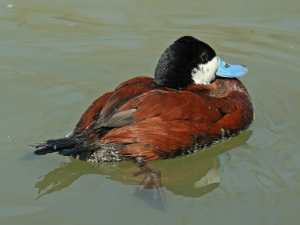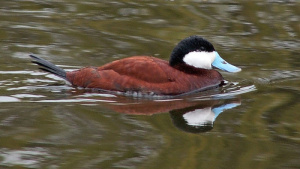The Ruddy Duck: A Bird With Style

An Introduction to the Natural History and Identification of the Ruddy Duck (Oxyura jamaicensis)
In the winter a common visitor to our shores, and much of the South-East and Western US, is the Ruddy Duck (Oxyura jamaicensis). These ducks breed mostly in the ponds and marshes of prairies, fresh water wetlands, and lakes but they travel south each year from the Midwest and Canada to grace us with their elegance and the male's colorful attire.
Physical Features of the Ruddy Duck
- Their length, snout to tail is about 15"
- They have characteristic stiff tails that they hold upright when they swim.
- Their heads are somewhat peaked on top.
- Their necks are fairly short and when they swim it looks like their head is somewhat pulled in, resting near their chest.
- The shape of their bill is shoveled or scooped on the end. In breeding season males have a bright blue bill that makes them quite dapper.
Coloration of the Ruddy Duck
Like most birds the Ruddy Duck has a summer plumage and a winter plumage. In the winter males and females look similar but the females (and first year young) are more dullish brown year round. Here are some markings that will help you identify Ruddy Ducks:
Heads:
- Both males and females have caps on their heads, extending down the nape of their neck. The males have a blackish cap in summer (breeding) and a darkish cap in winter. Females and first year young have a brownish cap in both seasons.
- Both males, females, and first year young have a distinct white cheek patch. This is one of the key things to look for when using binoculars and scanning winter waters for waterfowl.
- In females and first year young there is a single brown line (fuzzy looking) that extends from the base of the bill, across the the white cheek patch, and to the nape of the neck.
- Males have bright blue bills in breeding season, and darker bills in winter. Females and first year young have brownish bills.

Bodies:
- During breeding season males have a beautiful chestnut coloring on their backs and sides, while females and first year young are brownish-tan year round. (Remember, it's useful for juvenile ducks to look like females because they're non-breeding and they are sending an, "I'm not a threat" signal to the local males by their drab coloration)

Wings and Tails:
- All Ruddy Ducks (males and females) have a stiff pointed tail, which usually sticks up when they swim, making them easily identifiable at a distance.
- When Ruddy Ducks fly they have a noticeable white color on their underwing coverts (underwing feather coverings from their shoulder to their elbow) . Ruddy Ducks are also known for flying low over the water and making short rapid wing beats.
Vocalizations
You can hear a short sound clip of the male ruddy duck on the Cornell Ornithology website. Males usually make a series of clicks and pops to lure the female.
Commonly Confused: Don't Get Ruddy Ducks Confused with Bufflehead Ducks
Ruddy Ducks commonly mix in with flocks of Bufflehead Ducks, Golden Eyes, and Scaup. The most common mix-up is confusing Bufflehead Ducks with Ruddy Ducks. The size of the two ducks is similar, but Buffleheads have a white cap on the back of their heads and napes, with a black mask from their forehead to their neck, and the female Buffleheads do not have a full white cheek patch. Buffleheads also do not hold their tail stiff and erect. Additionally, male Buffleheads have a whitish chest and body with a distinct black back. Check out the pictures below.




Female Ruddy Duck
This is only a short introduction, and the best way to recognize waterfowl is to get out into the field and learn by seeing and doing. If you want to practice learning North American Waterfowl you can visit the North American Flyways website and guide, Quizlet for their "North American Waterfowl Quiz (advanced)," or you can try the "Ducks Unlimited" quiz and trivia page.

